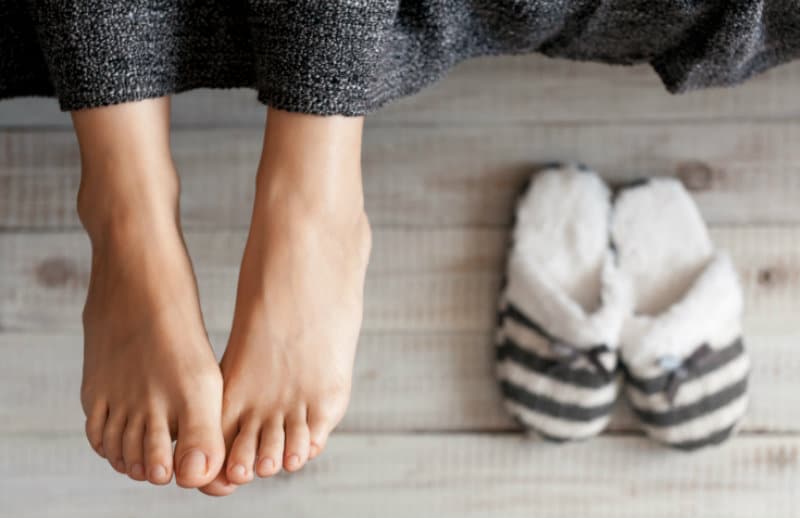How to Have a Good Morning Without Heel Pain
Let’s face it: we’re not all morning people.
If you wake up at 6 a.m. (or maybe even before!) every morning so you can make yourself a nice breakfast and even fit in a jog or workout before heading to work or taking the kids to school, that’s great!
If getting out of bed takes just about all your willpower, and your brain feels like it won’t even turn on until 10? Well, that’s not ideal, but not exactly rare, either.
But regardless of which category you fall into, there’s nothing like a case of heel pain to wreck your morning routine.
If you’re a morning person, heel pain can instantly turn the best part of the day into the worst. And if you aren’t, it makes getting out of bed that much harder.
Morning Heel Pain: What’s Going On?
Heel pain that spikes in the morning is a classic symptom of plantar fasciitis, the most common heel pain condition suffered by American adults. (You might notice heel pain also tends to spike after any substantial “rest” period, for example after watching a movie or reading a book for a few hours.) What’s going on? Plantar fasciitis is the result of inflammation in the plantar fascia, a tough ligament that runs across your entire arch and attaches to your heel bone. That inflammation causes it to tense up and contract during periods of rest. When you put weight on your feet again, the plantar fascia is pulled and stretched painfully. Give it ten or fifteen minutes, and the pain usually recedes back into a dull ache. But you know it’ll be back to greet you the next morning.Home Remedies for Morning Heel Pain
Fortunately, heel pain from plantar fasciitis is very treatable. Here are our top home care strategies to help you start enjoying your morning again—or at least making it less uncomfortable.Sleep Until Noon
Just kidding. Although this one is technically guaranteed to work, it’s probably not feasible or desirable for most people. Plus, then you just have early afternoon heel pain.Wear Better Shoes
Give your shoes a good, hard look. Are they currently meeting the needs of your feet? Shoes should be replaced if:- They don’t fit. That one ought to be obvious.
- They don’t provide enough support or cushioning for your feet. High heels, ballet flats, flip flops, etc. are notorious for this and should be worn only sparingly.
- They aren’t appropriate for your activity. If you’re an athlete, for example, you should wear sport-specific shoes.
- They are beat up. Worn out shoes can’t absorb impact forces as well as they need to. Keep in mind that even if you keep the exterior of your shoes immaculately clean and in good repair, the midsoles will still compress and lose their effectiveness over time.
Modify Your Activities
Although short periods of rest trigger a spike in pain, longer periods of rest (taking a break from sports for a week or so, for example) give your heels an opportunity to actually, well, heal. In the meantime, you can modify your activities or environment to reduce daily wear and tear. For example:- Switch to a low-impact sport like cycling or swimming
- Try running on friendlier terrain—softer surfaces, flatter grade, etc.
- Take regular breaks at work, or place a cushioned mat at your workstation if you do a lot of standing on the job.
Stretch Your Feet
Making time to stretch regularly can relieve the tension in your plantar fascia and help speed up the healing processes. Stretches and massage for the arches are highly recommended. Stretch your toes, Achilles tendons, and calf muscles as well. All these areas are interconnected; a looser Achilles (for example) won’t pull as hard on the plantar fascia, which means less pain overall.Professional Treatment Options for Morning Heel Pain
Our hope is that, with a little at-home TLC, you can get your feet back in shape without needing our help at all. However, if heel pain persists for longer than a week, or keeps getting worse, you’re going to want to give us a call. There is good news here—we are very good at treating plantar fasciitis conservatively. Just because you can’t fix it on your own doesn’t necessarily mean you need surgery. In fact, surgical treatment for heel pain is only required in extremely rare circumstances. In addition to making our own recommendations about shoes, stretches, and activity modifications try, we can also provide:- Stronger pain medications. If ibuprofen isn’t cutting it for you, we can prescribe something stronger, or give you a corticosteroid injection.
- Biomechanical evaluations. You might (or might not) be surprised to learn that bad biomechanics are commonly lurking “in the background” of a heel pain diagnosis. A fundamental flaw in your foot structure or walking gait may increase weight and pressure on the heels and arches. Evaluating your biomechanics is often the first step to crafting an effective long-term solution to chronic pain.
- Custom orthotics. Often, this is the result of biomechanical evaluation. Custom orthotics are personalized to your exact specifications. They replace the regular insoles in your shoes. The right pair of orthotics support your feet with any additional cushioning and support it may needs, and can even correct gait abnormalities to a degree. (More minor cases of heel pain might be remedied with prefabricated, over-the-counter insoles instead of customs. We can help you figure out which type you need.)
- Night splints. These are splints you wear at night to keep your plantar fascia and calves stretched (lengthened) while you sleep. Your first footsteps of the morning should be a lot less painful as a result.


